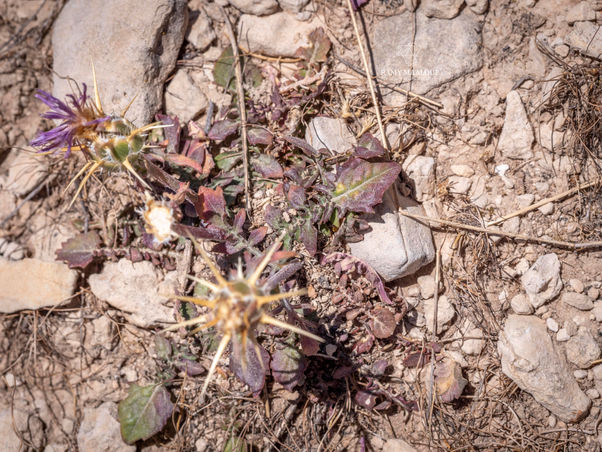Family |
Asteraceae
Centaurea eryngioides
Lam.
Centaurea eryngioides Lam.
(Nouvelle Flore du Liban et de la Syrie, vol. 3, Pl. CCLXXXIX nº 1–2; 1983)
Life-form & habit: Perennial, green, nearly glabrous or with scattered articulate hairs; sometimes with tufts of hairs at the base of leaves. Stems 15–35 cm tall or more, usually simple or with a few lower branches bearing solitary capitula.
Leaves: Basal and lower cauline leaves lyrate, with a lanceolate to subcordate terminal segment and smaller lateral ones interrupted by orbicular lobes. Middle and upper leaves smaller, lyrate, lobed, or entire.
Inflorescence & flowers: Involucre ovate, 20–25 mm long × 15–20 mm wide; peduncles long and nearly naked.
Bracts: Glabrous or slightly tomentose, fringed with a narrow line of white cilia; median bracts with a strong, straw-yellow to pale brown spine (15–30 mm long), spinulose at base, spreading.
Flowers: Rose-purple (rarely yellowish), marginal florets non-radiant. Anther tube slightly curved.
Fruit: Achenes 4.5–5.5 mm long, strongly flattened.
Pappus: 7–9(–10) mm long; inner series 1.5–2.5 mm.
Phenology: Flowers from May to July.
Habitat & elevation: Arid and semi-arid hills, east of Lebanon and in the Anti-Lebanon range.
Lebanese distribution: Ve. Between ‘Aïnata and Deir-el-Ahmar, ‘Aïnata, Makmel descent, Mchaitiyé–‘Aïnata; St. Ras Baalbek, Orontes springs.
Syrian distribution: A.L. Qaldoun, Yabroud, Qara above Nebk, Jabal el-Qorn, Qastal, Jabal Abou ‘Ata; St. Jabal Abou Qoch; Dam. Jabal Qasyoun.
Native range: Egypt, Lebanon-Syria, Palestine, Saudi Arabia, Sinai (KEW)














